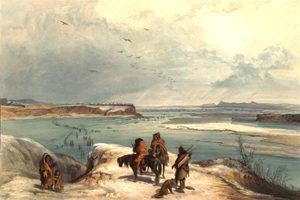Fort Clark, North Dakota, was another non-military fort built as a trading post by fur trader James Kipp in 1830.
Before James Kipp, an employee of the American Fur Company, built Fort Clark; the location was already home to the Mandan Indians, who had built a village of earth-covered homes on the bluffs of the west bank of the Missouri River at the confluence of Chardon Creek and Clark’s Creek. Kipp built the trading post in 1830-31 just south of the village to enhance trade with the Indians. The post measured 120 by 160 feet, was surrounded by a palisade, and inside its walls were a home for head trader Francis A. Chardon and other fur trade buildings.
The first steamboat up the Upper Missouri River arrived at Fort Clark in 1832, delivering all types of trade goods and returned with hundreds of bison robes and beaver pelts. Unfortunately, the steamboats also brought diseases that the Mandan Indians had never been exposed to. In June 1837, one of the boats was carrying passengers infected with smallpox. The disease swept through the Mandan village within no time, killing about 90 percent of them. A few months later, those that survived abandoned their village. The following year, Arikara Indians moved into the abandoned village. For several years, they did well, until yet another epidemic hit them – this time cholera in 1851, which took many lives. Another smallpox epidemic occurred in 1856, further reducing their numbers. The fur traders moved from the site after the trading post was severely damaged by fire in 1860. Despite the devastating tragedies, the Arikara continued to use the village as a summer home until 1861, when Dakota Indians attacked them. What little was left of the abandoned fort was scavenged by passing steamboats to use as firewood.
Though no buildings remain of the old trading post today, it has become an important archeological site due to its well-preserved record of the fur trade and personal tragedy. The archeological remains of the large earth lodge village, cemetery, and trading post are now protected and listed on the National Register of Historic Places. It is located about 1 ¼ mile west of the town of Fort Clark in Mercer County. Open daily during the summer; there is no admission fee to the archeological site, which provides a self-guided tour, interpretive signs, a picnic area, and an observation deck.
More Information:
Fort Clark State Historic Site
HC 2, Box 26
Center, North Dakota 58530
701-794-8832
© Kathy Alexander/Legends of America, updated November 2022.
Also See:

